Politics
Data Story: Even Counting For Tablighi Jamaat’s Recklessness, India Containing Covid-19 At Stage Two Itself
Venu Gopal Narayanan
Apr 03, 2020, 07:37 PM | Updated 07:37 PM IST
Save & read from anywhere!
Bookmark stories for easy access on any device or the Swarajya app.
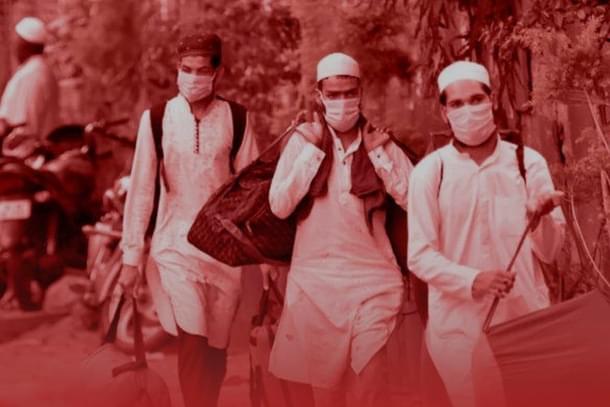

Everything was going fairly well during the first week of the lockdown, until it came to light that a massive Wuhan virus cluster had formed at the Tablighi Jamaat’s centre in Nizamuddin, Delhi.
Over 29 and 30 March, we learnt to our consternation that a few thousand attendees at a religious conference there, many of whom tested positive subsequently, had not just violated multiple public health advisories by congregating in Nizamuddin, but then exacerbated the situation as well, by irresponsibly using public transport in a dangerously cavalier manner, to travel to various corners of India.
Naturally, this unconscionable act was followed by a rise in the number of cases being reported daily, with most of those being imprudent attendees of the Jamaat’s congregation.
As this piece goes to the press, reports indicate that the areas worst affected courtesy our Tablighi brethren include demographic localities of Delhi, Tamil Nadu, Andhra Pradesh and Telangana, with spurts in Rajasthan, Karnataka, Assam and The Andamans.
However, as we shall see, while the Tablighi Jamaat stands morally indicted of gross, unconscionable recklessness and flagrant irresponsibility, this new development is still not cause for concern that the epidemic would spread across our land, into a third stage of community transmission.
A principal reason for this is that while the number of Tablighi Jamaat (TJ) Wuhan virus-positive patients may appear fearfully large, the accompanying trends have not shifted in an alarming fashion. This inference reiterates Swarajya’s sustained emphasis on trends over numbers, validates the views that we are indeed containing the epidemic at stage two (local transmission), and offers some welcome relief to a citizenry under lockdown.
The numbers first:
A table below segregates identified Tablighi Jamaat infections from other cases. Figures are based on crowd-sourced cluster-mapping as on the night of 2 April. They are necessarily adumbrative even if 9,000 attendees and their contacts have already been identified and quarantined, since details are still emerging.
The numbers may grow, and more cases may be transferred from the ‘Others’ column to the TJ column, as authorities confirm further attendees of the Nizamuddin conference and their contacts.
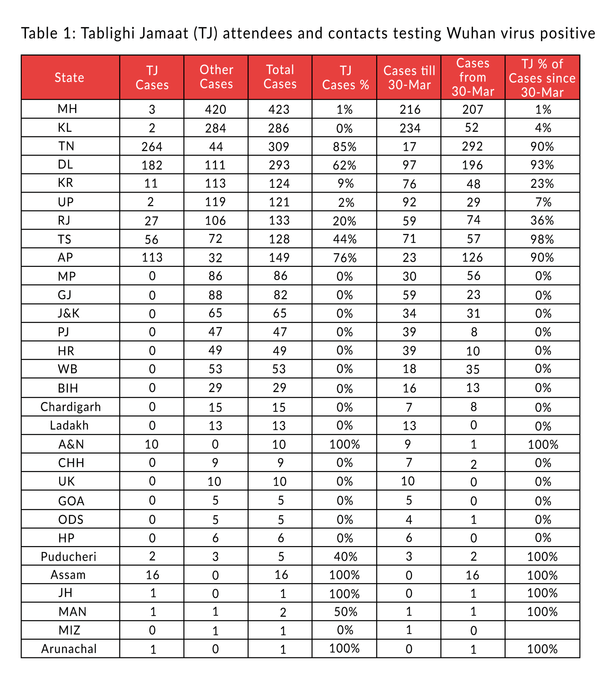
From this table we see that the bulk of the Jamaat’s unforgiveable recklessness has, thus far, principally affected selected states.
Now, considering that a significant portion of the TJ attendees and their contacts left Delhi before the 23 March, the manifestations of illness, if any, would have taken place while the bulk of the country was headed into lockdown.
Don’t forget that one break of the chain of transmission happened on 22 March with the ‘Janata Curfew’.
Indeed, in hindsight, looking at the TJ numbers that are now emerging, the crucial contribution of the ‘Janata Curfew’ in impeding the pandemic’s progress becomes substantially more influential.
We now see with greater clarity, that it was a serendipitously judicious move, taken without foreknowledge of what effects the Tablighi Jamaat’s abject puerility in disregarding government orders would have.
Secondly, since the country is in lockdown, any local transmissions of the Wuhan virus taking place are doing so largely within the confines of isolated premises. The bulk of the populace remains spared. Thus, even those TJ attendees who may be infected, and are avoiding detection by switching off their phones, and surreptitiously ensconcing themselves in isolation, in fact, are still fulfilling the prime objectives of the lockdown – ensuring that the virus doesn’t spread further.
Consequently, it would be technically incorrect to construe the recent discovery of the Nizamuddin cluster as indicative of the epidemic’s further spread into the next stage. Only multiple isolated new clusters have formed, and that’s not the same thing as a spread.
So, how does Tablighi Jamaat benevolence impact the national picture? Not by much. For proof, look at the chart below:
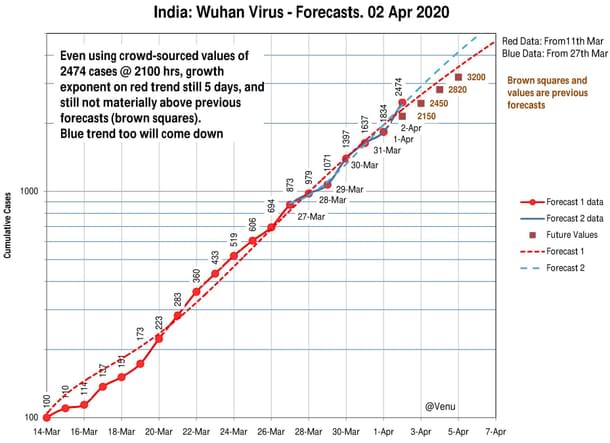
As explained in detail earlier (here, and here), the focus has to remain on the trends, rather than individual numbers.
Now, even using a crowd-sourced number of 2,474 positive cases (as on the night of 2 April, and higher than the official figure of 2,069), we see that the red trend does not shift by much.
The blue trend is a sensitivity test, run to demonstrate that fluctuations in numbers (including spikes, surges, spurts and other assorted synonyms) are strongly dependent on the data set selected. Meaning, that if we use only the most recent data (as done for generating the blue trend), the resultant forecast overestimates by a fair bit.
On the contrary, when we use all the data points, the red line, we see two things: one, that a clear, sustained, extrapolative trend is self-evident; and second, that this red trend is far less affected by fluctuations, than if we were to make the mistake of looking at a recent rise in numbers in isolation (blue trend).
If we are still sceptical, then more evidence is offered by the continued proximity of the red trend to an older forecast generated before the Jamaat’s charity came to light: look at the brown squares and values in Chart 1 above. See how closely they line up with the red forecast line?
Very importantly, it must also be noted that the old forecast projected 2,450 cases by 3 April. Now, even if we assume the crowd-sourced value of 2,474 cases on 2 April to be valid, there is still only a day’s difference between two different projections on when we would touch the 2,400 mark. This means that the Tablighi Jamaat episode has had less of an overall impact at the national level than some may think.
Next, just to be sure, let us run one final test using the official numbers (which is what we should do if we wish to retain consistency in interpretations and analysis).
Chart 2, below,was prepared using the government figure of 2,069 cases for 2 April. As we see to our relief, both the blue and red trends align with the older forecast, even though the new forecasts include the Jamaat numbers.
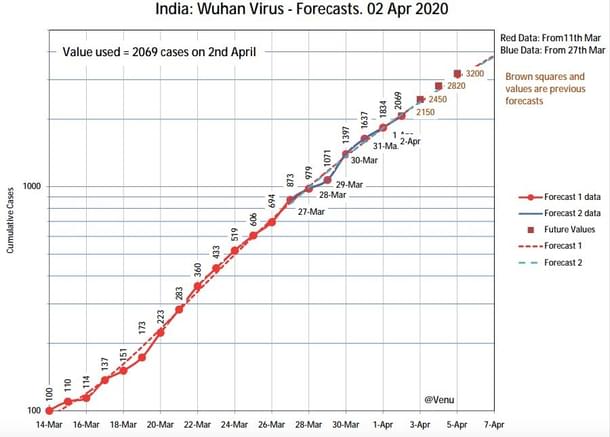
In corroboration of the above analysis, the latest government numbers at noon on 3 April are 2,301 cases. Once again, encouragingly, this is holding to both trends – the red one with the latest data, and the brown, older one without. Want visual proof? Here’s one more chart:
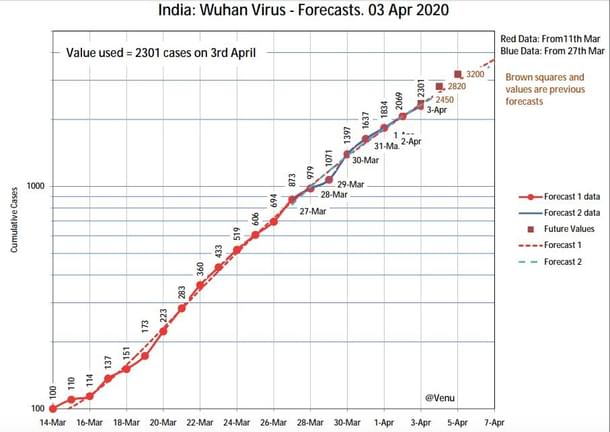
From this analysis, we must therefore conclude that a key distinction has to be made between the rate at which Tablighi Jamaat numbers are being uncovered and reported, and the other cases with different origins.
One is not the other, and neither is stage three. Enumeration of cases that manifested while the nation was into lockdown cannot be taken as evidence of the epidemic’s further, continued spread. To do so would be technically incorrect.
Now, finally, as the process of identifying attendees goes on, those numbers will go up for a few days. But then, because the cases are getting contained, they will come down too. These new numbers will show up as fluctuations, perhaps even as a transitory shift in growth exponents, but they are not sustainable, and they would not cause a radical trend shift.
What this means for India, is that as long as we follow lockdown protocols diligently, we would be able to successfully overcome any and all surges, spikes, or spurts caused by the Tablighi Jamaat cluster.
Venu Gopal Narayanan is an independent upstream petroleum consultant who focuses on energy, geopolitics, current affairs and electoral arithmetic. He tweets at @ideorogue.





